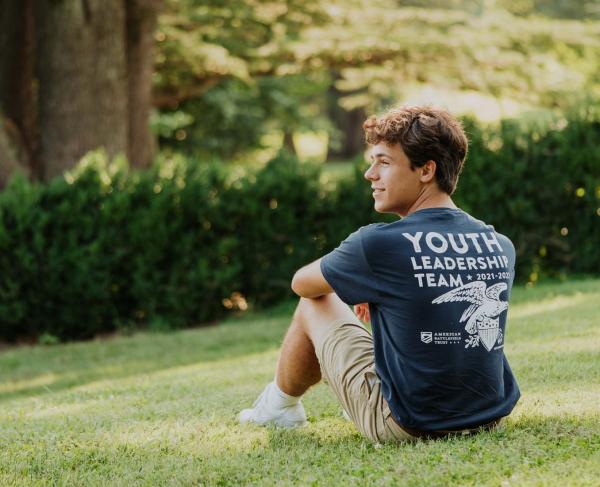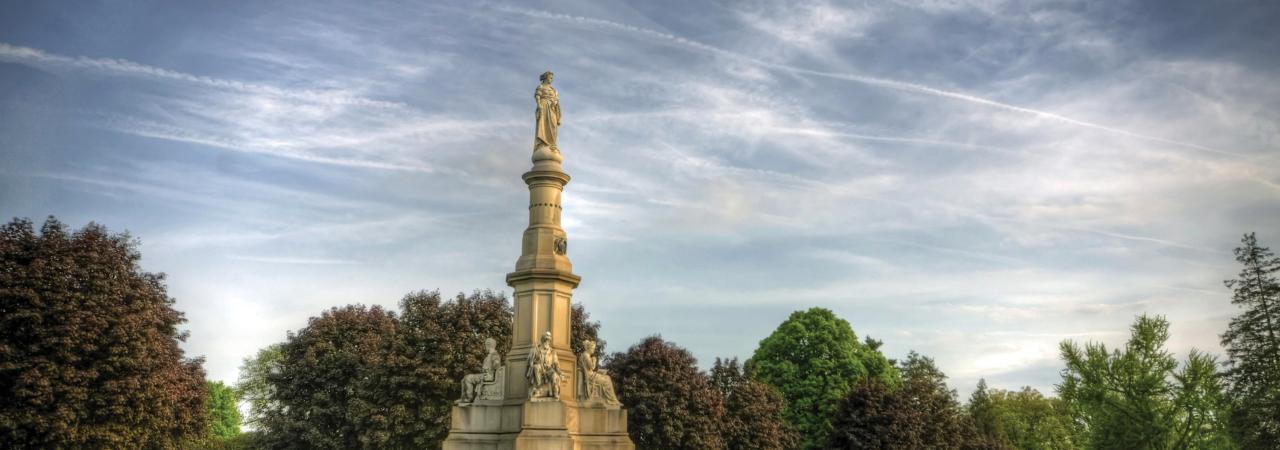
“Now, the several States that stood as one in that high cause come here in their own name, – in the noblest sphere of their State rights,– to ratify and confirm this action of their delegates; to set these monuments as seals to their own great deeds, and new testament of life…. But these monuments are not to commemorate the dead alone. Death was but the divine acceptance of life freely offered by every one. Service was the central fact. That fact, and that truth, these monuments commemorate.”
Joshua L. Chamberlain, October 3, 1889
Thanks to the charisma of the unit’s wartime commander and his eloquence at the dedication ceremony — plus a heroic portrayal in the Pulitzer Prize-winning novel The Killer Angels — the 20th Maine Monument has become among the most visited at Gettysburg. But is just one of the more than 1,300 markers of all sizes and shapes dot the battlefield, many placed by the veterans themselves. Through their symbolism and placement, these plaques, sculptures and stones tell us much about the men who fought at Gettysburg.
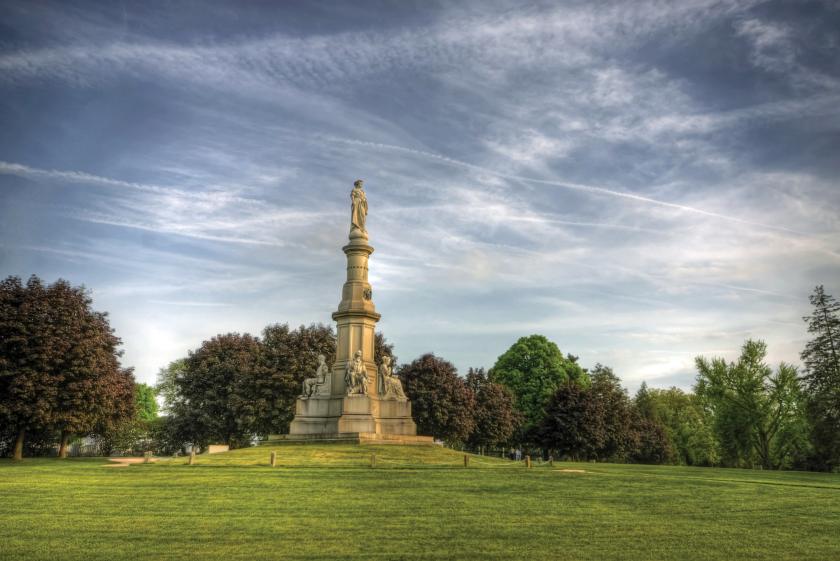
Two dramatically different sculptures compete for the title of Gettysburg’s first monument, but both are located within the original confines of the Soldiers’ National Cemetery. The cornerstone of the massive Soldiers National Monument — standing 60 feet high and replete with marble statues representing War, History, Peace and Plenty, topped by the “Genius of Liberty” — was laid on July 4, 1865, but not completed until August 1869. Meanwhile, in 1867, the survivors of the 1st Minnesota Infantry, which suffered 82 percent casualties on July 2, dedicated a small marble urn, still planted with flowers today, to their fallen comrades. The first monument to an individual was a bronze sculpture of Maj. Gen. John F. Reynolds, dedicated in 1872. In 1878 the first two memorial markers appeared outside the cemetery — on Little Round Top commemorating the mortal wounding of Col. Strong Vincent and near the Wheatfield marking honoring the death of Col. Fred Taylor. The first unit to receive a monument on the site where it fought was the 2nd Massachusetts, which led a daring charge across Spangler Meadow near Culp’s Hill.
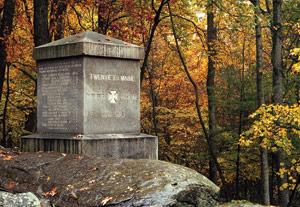
By May 1887, no fewer than 90 monuments to regiments and batteries had been placed on the battlefield — including those to all 30 Massachusetts units engaged — each one approved individually for design and location by the Gettysburg Battlefield Memorial Association (GBMA). To impose organization to the process, the Association developed the so-called Line of Battle Rule, dictating that monuments would be erected along the line held by the relevant brigade, with those of units that subsequently occupied the same ground staggered to the rear at regular intervals. Units were also to place simple stone markers, at least two feet tall, indicating their left and right flanks. The process was not without controversy: final placement of the sculptural monument to the 72nd Pennsylvania Infantry — the Philadelphia Fire Zouaves — was decided by the Pennsylvania Supreme Court.
These early monumentation efforts, as well as the GBMA’s acquisition of land at key battlefield locations, were often driven by veterans groups but financed through direct appropriations from state governments, meaning that the presence of the U.S. Regular Army units and even the Army of Northern Virginia was virtually ignored. Moreover, since the Confederacy had fought an offensive engagement, the Line of Battle Rule, meant that any markers erected would likely be far from where a unit performed heroic deeds or suffered heavy casualties. Further, a lack of Southern desire to commemorate a stinging defeat was coupled with outright hostility toward the idea from within the GBMA. On the battle’s 25th anniversary, only two markers alluded to the presence of Southern troops: a plaque near the Angle commemorating Brig. Gen. Lewis Armistead’s farthest advance during Pickett’s Charge (1887) and the 2nd Maryland Infantry monument on Culp's Hill (1884).
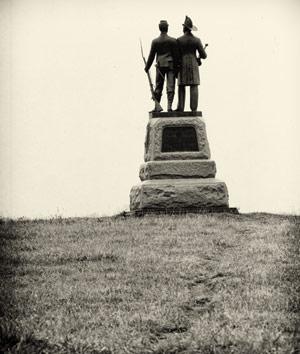
It was only after Congress approved the creation of Gettysburg National Military Park in 1895, and the War Department’s absorption of the land held by the GBMA, that protection and commemoration of the battle’s full scope truly began. Using its power of condemnation, the federal government began acquiring land associated with Confederate positions. Next, the War Department began the process of identifying the location of all Southern units on the field, a process that had largely been completed for the Army of the Potomac using funds allocated by states to the GBMA. By 1921, the War Department had completed the daunting task “[of] plac[ing] the principal tablet or monument of each command at the position occupied by the command in the main line of battle, and to mark the several important positions subsequently reached by each command in the course of the battle by subordinate and ancillary tablets, with appropriate brief inscriptions giving interesting details and occurrences and noting the day and hour as nearly as possible.” These granite markers with iron or bronze tablets contain narrative descriptions of the unit and its role in the battle. Differences in color and shape of various elements distinguish the types of marker — say Union brigade from Confederate division — at a glance, but they lack the sculptural symbolism of individually erected memorials.
The process of each former Confederate state dedicating a joint monument to its troops along Seminary Ridge began on the battle’s 50th anniversary, with the erection of the granite base for the imposing Virginia Monument. Beyond its 26-foot granite pedestal, the monument features a bronze sculpture of six men representing the “sons” of Virginia to whom the piece is dedicated, and a bronze equestrian statue of Confederate Gen. Robert E. Lee astride Traveller. The bronze North Carolina Monument was dedicated in 1929, with the granite and bronze Alabama Monument following in 1933. Additional Confederate state monuments were added during and immediately following the centennial period, with the privately funded Tennessee Monument completed in 1982.
The myriad monuments of Gettysburg run the gamut in their designs — from the massive and ornate, to the modest and austere. Initially, there were no restrictions or regulations on design or manufacture, resulting in a small number of monuments built from fragile materials that threatened their longevity. In addition to requiring that all future monuments be erected from granite or bronze, and imposing guidelines for the size and depth of engraving, the GBMA instituted a number of other requisites for future construction.
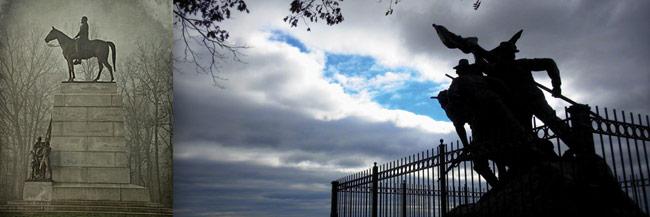
Beginning in July 1887, all regiments were to be fully identified with number, state, brigade, division and corps. Casualty figures in agreement with the official War Department records were required; a summary of the unit’s movements at Gettysburg and overall service record in the war were suggested. Beyond those compulsory items, many of Gettysburg’s monuments share symbolic elements, such as the incorporation of official badges designating branch of service — a horn for infantry or crossed sabers for cavalry, for example — and corps — the II Corps’ clover leaf or the V Corps’ Maltese cross. State seals and other emblems of pre-war life are also common, but largely beyond that, the monuments of Gettysburg are as diverse and unique as the experiences of the units that fought there.
If, beyond the War Department plaques, there is no “typical” Gettysburg monument, there are a number that are particularly striking and personal in their design. For example, the Celtic cross and prostrate wolfhound, long a symbol of honor and fidelity, are unmistakable hallmarks of the Irish Brigade memorial in the Rose Woods near the Wheatfield. The 73rd New York, or Fire Zouaves, placed both a soldier and a New York fireman — the pre-war occupation of much of the regiment — atop its memorial. A Native American teepee adorns the 42nd New York Infantry, raised under the patronage of Tammany Hall, an institution named for the legendary leader of the Lenape, or Delaware, tribe who negotiated with William Penn during colonial times. The 11th Pennsylvania chose to include a portrait of Sallie, their beloved canine mascot, on their monument.
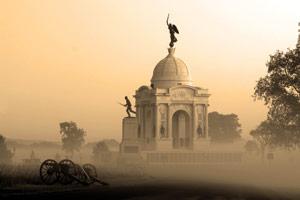
While the practice of including the names of a unit’s dead, rather than just their number, is not uncommon, one monument goes well beyond the norm. The towering Pennsylvania State Memorial (at 110 feet tall, the largest monument on the battlefield) incorporates individual sculptures commemorating the six Keystone State generals who fought at Gettysburg — plus President Abraham Lincoln and Governor Andrew Curtain — and 90 bronze plaques emblazoned with the names of each of the 34,530 Pennsylvanians who fought in the battle.
A number of individuals have been immortalized in bronze on the battlefield through independent statuary not attached to a unit memorial. Most of these commemorate unit commanders from the opposing armies, but a few are to individuals of lesser rank, or even private citizens. On the first day’s field stands a monument to John Burns, a septuagenarian veteran of the War of 1812, who again took up arms when an enemy army threatened and was wounded three times fighting alongside the Iron Brigade. Near the Gettysburg fire station is a memorial to Sgt. Amos Humiston, whose body had no identification save a photograph of three children — an image that appeared in newspapers across the nation, leading to his identification and the foundation of the Soldiers’ Orphans’ Home. Visitors to Ziegler’s Grove find a more modern addition to Gettysburg’s monument collection, a 1956 sculpture depicting Albert Woolson of Duluth, Minn. Although only a drummer boy at Gettysburg, years after the war, he served as vice commander of the Grand Army of the Republic. The last remaining veteran of the Union Army, Woolson died in August 1956 at age 109.
A monument on the steps to Christ Lutheran Church in town was erected in memory of Rev. Horatio S. Howell, chaplain of the 90th Pennsylvania, who was killed while visiting the wounded inside after it had been converted into a hospital. A statue of Rev. William Corby, C.S.C., near the Weickert Farm commemorates the Catholic priest delivering a general absolution to the Irish Brigade before it charged into battle; an exact copy stands outside Corby Hall at the University of Notre Dame, where he went on to serve two post-war terms as president. Just inside the gates of Evergreen Cemetery, the Gettysburg Women's Memorial depicts cemetery caretaker Elizabeth Thorn, who buried 91 casualties of the battle while six months pregnant.
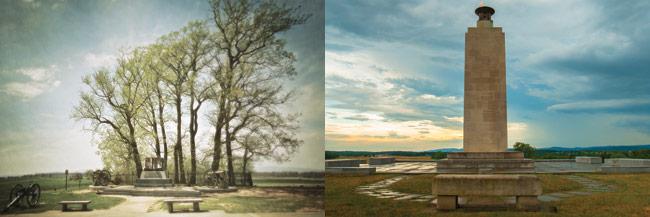
Two of Gettysburg’s most iconic monuments commemorate both Union and Confederate troops, helping symbolize the reunification of the country in the decades following the war. The High Water Mark of the Rebellion, an oversized bronze book bearing the names of the units involved in Pickett’s Charge and its repulse, was dedicated behind the Copse of Trees, the spot commonly accepted as the furthest point of the assault, in 1892 by the GBMA. The idea for the Eternal Peace Light Memorial on Oak Hill was born during the 50th anniversary commemoration of the battle, when veterans decided they should erect a symbol of the reunited nation. Bearing the inscription “Peace Eternal in a Nation United,” the dedication of this 85-foot tall monument made of Maine granite and Alabama limestone was attended by more than 250,000 people on July 3, 1938. The occasion marked the last great reunion of Civil War veterans: of the approximately 2,000 old soldiers present, the youngest was 88. In his keynote remarks, President Franklin D. Roosevelt said: “All of them we honor, not asking under which Flag they fought then — thankful that they stand together under one Flag now.”
Related Battles
23,049
28,063


